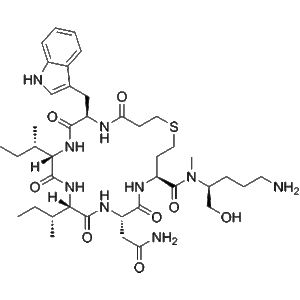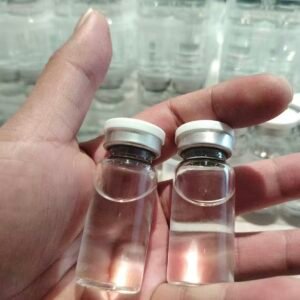No products in the cart.
Sale
Barusiban (CAS 285571-64-4) | GMP Supplier & Manufacturer for Research Use
Original price was: $16.00.$15.00Current price is: $15.00.
Barusiban (FE-200440) is a selective oxytocin receptor antagonist that inhibits oxytocin-induced uterine contractions with high potency (Ki = 0.8 nM). It serves as a valuable tool in preclinical studies of preterm labor, reproductive biology, and infertility. Supplied in GMP-grade quality for reproducible laboratory experiments. For laboratory research use only.
Description
Product Description
Barusiban (CAS 285571-64-4), also known as FE-200440, is a synthetic peptide-based compound classified as an oxytocin receptor (OT-R) antagonist. It is a highly potent and selective molecule designed to inhibit OT-induced uterine contractions, making it indispensable for preclinical research in reproductive biology, infertility studies, and preterm labor modeling.
Background and Significance:
Oxytocin is critical in parturition, lactation, and reproductive signaling. The uterine expression of oxytocin receptors governs contraction during labor. Premature receptor activation leads to preterm labor, a major cause of neonatal complications. Barusiban blocks these receptors, offering precise control over uterine contractility in experimental settings, and serves as a pharmacological tool for studying oxytocin pathways and potential therapeutic interventions.
Chemical Properties & Structural Design:
Barusiban is a synthetic nonapeptide structurally optimized for high receptor selectivity and metabolic stability. It demonstrates minimal off-target effects on vasopressin receptors and provides prolonged receptor occupancy. Compared to first-generation OT-R antagonists, Barusiban shows superior potency, stability, and efficacy in both in vitro and in vivo systems.
Research Value in Preterm Labor (PTL) Studies:
Preterm labor accounts for significant perinatal morbidity and mortality. Barusiban is widely used in rodent and primate models to study OT-induced uterine contraction suppression. Experimental data shows that Barusiban reduces contraction frequency and intensity, prolongs gestation, and stabilizes uterine activity. It is a benchmark tool for preclinical investigation of uterine physiology and pharmacological interventions for PTL.
Applications in Fertility & IVF Research:
Barusiban is applied in IVF research to reduce uterine hyperactivity, facilitating embryo implantation and improving implantation success rates. It also allows mechanistic studies of uterine quiescence, implantation biology, and OT signaling in infertility research.
Advantages over Other OT-R Antagonists:
Barusiban demonstrates higher receptor selectivity, stronger binding affinity, and longer duration of action than earlier OT-R antagonists such as atosiban. These characteristics make it ideal for studies requiring sustained receptor blockade and reproducible outcomes.
GMP-Grade Production for Research Reliability:
Supplied in GMP-grade quality, Barusiban ensures consistent peptide integrity, batch-to-batch reproducibility, and high purity. Lyophilized formulation provides long-term stability and compatibility with various laboratory buffers.
Disclaimer: For laboratory research use only. Not for human or veterinary use.
Product Specifications
| Parameter | Details |
|---|---|
| Product Name | Barusiban |
| Synonyms | FE-200440 |
| CAS Number | 285571-64-4 |
| Molecular Type | Synthetic oxytocin receptor antagonist peptide |
| Molecular Formula | C??H??N??O?? |
| Molecular Weight | ~1184.4 g/mol |
| Purity | ? 98% (HPLC) |
| Appearance | White to off-white lyophilized powder |
| Solubility | Soluble in aqueous buffers and DMSO |
| Stability | Stable ? 24 months in lyophilized form |
| Storage Conditions | Store at -20°C; protect from moisture and light |
| Mechanism | Selective oxytocin receptor (OT-R) antagonist |
| GMP Compliance | Manufactured under GMP-certified facilities |
| Applications | Preterm labor research, IVF implantation studies, infertility mechanisms |
| Availability | Wholesale & retail supply |
| Experimental Models | Rodent, non-human primate, uterine smooth muscle cells |
| Safety Considerations | Handle under standard laboratory protocols; research use only |
Mechanism of Action & Research Applications
Barusiban binds selectively to the oxytocin receptor (OT-R), a G-protein-coupled receptor highly expressed in uterine smooth muscle. By competitively blocking oxytocin binding, it inhibits calcium mobilization and downstream contraction pathways.
Mechanism Highlights:
Oxytocin receptor antagonism: prevents OT-induced uterine contraction.
High selectivity: minimal cross-reactivity with vasopressin receptors.
Prolonged receptor occupancy: structural modifications provide sustained action.
Research Applications:
Preterm labor studies: modeling uterine contractility suppression.
IVF implantation research: reducing contractions to enhance embryo implantation.
Infertility research: studying uterine hyperactivity mechanisms.
Comparative endocrinology: species-specific OT signaling investigations.
Pharmacological benchmarking: reference OT-R antagonist.
Translational research: informs novel tocolytic and reproductive therapeutics.

Side Effects (For Reference in Research Models)
Uterine quiescence (intended pharmacological effect)
Hormonal modulation: minor vasopressin cross-signaling at high concentrations
Minimal cardiovascular impact in preclinical models
Possible influence on implantation timing in IVF studies
Dose-dependent inhibition of uterine contractions
Species-specific variability in pharmacodynamics
Loss of activity with repeated freeze-thaw cycles
Note: These findings are strictly for research reference. Barusiban is not intended for human or veterinary use.
Disclaimer
For laboratory research use only. Not for human or veterinary use.
Keywords
CAS 285571-64-4
FE-200440 oxytocin receptor antagonist
Barusiban GMP supplier
Barusiban preterm labor research peptide
IVF research oxytocin antagonist
Infertility research Barusiban
Laboratory OT-R antagonist peptide
Uterine contraction research peptide
Oxytocin receptor blockade compound
Additional information
| Weight | 0.8 kg |
|---|
What is Barusiban?
Barusiban is a selective oxytocin receptor antagonist used in reproductive biology research.
What is the CAS number of Barusiban?
CAS No. 285571-64-4.
What is the synonym for Barusiban?
FE-200440.
How does Barusiban work?
It blocks oxytocin receptor activation and prevents uterine contractions.
What is the binding affinity of Barusiban?
Ki = 0.8 nM for OT-R.
What research areas use Barusiban?
Preterm labor, IVF, infertility, and oxytocin signaling studies.
Is Barusiban GMP-manufactured?
Yes, supplied under GMP-certified conditions.
How should Barusiban be stored?
At -20°C, protected from light and moisture.

















Reviews
There are no reviews yet.